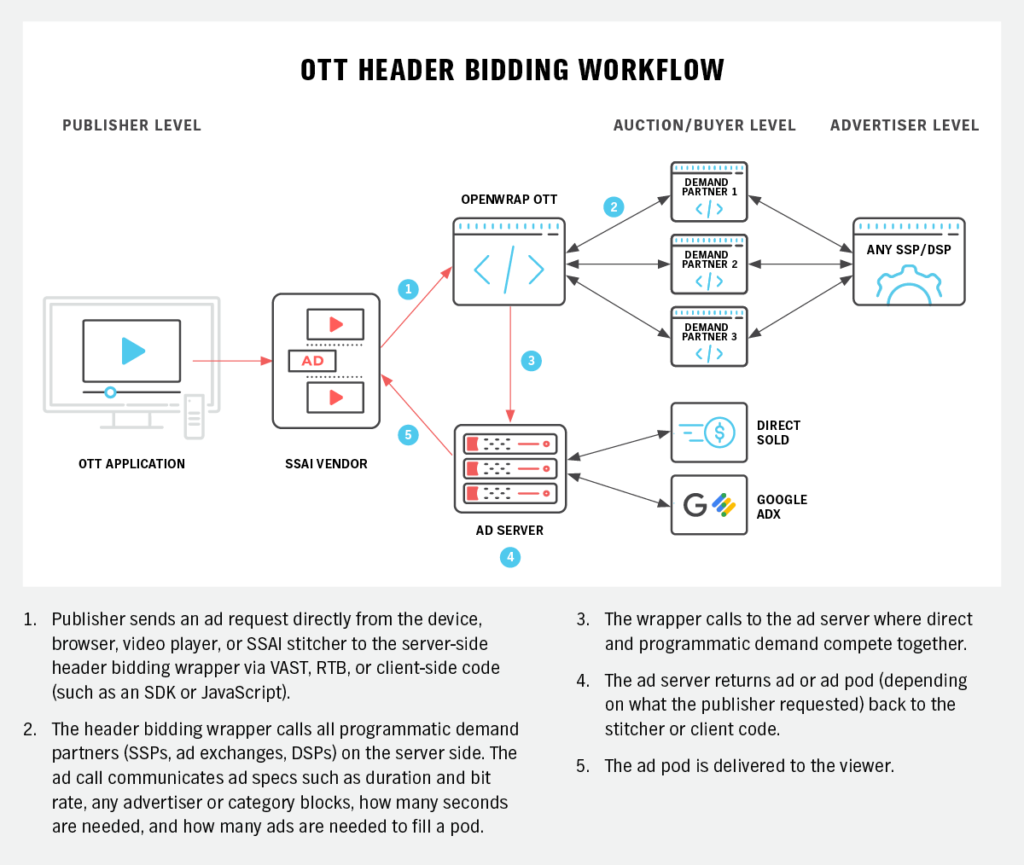The growth of streaming TV, along with a shift from linear TV advertising, means that it’s full-steam ahead for programmatic over-the-top (OTT) and connected TV (CTV). With the ecosystem growing and demand coming from all over (exchanges, demand side platforms, ad servers, etc.), it’s becoming harder to assemble an ad pod that can deliver on business rules and publisher monetization, while giving OTT viewership a high quality viewing experience on par with TV.
Programmatic technology is evolving to meet these complex – and seemingly conflicting – needs. New solutions like OpenWrap OTT, PubMatic’s Prebid-powered header bidding solution, allow publishers to centralize 100% of direct and programmatic demand in a server-side parallel auction that is optimized for user experience.
Getting Ahead of It
Header bidding within the ad pod provides publishers and advertisers numerous benefits through flattening the waterfall to enable all demand bid and compete simultaneously. As brands increase spend through programmatic channels, initiatives like supply path optimization (SPO) are unlocking high-quality demand potential. This demand can scale effectively through server-side bidding, adding incremental yield and revenue on top of current demand while maintaining quality control. Best-in-class header bidding solutions should give publishers the tools to respond to real-time changes in viewer behavior and increase advertiser access to programmatic and direct inventory that was previously “stuck” in the ad server.
Time to Mod the Pod
Commercial breaks in linear TV require a long spreadsheet with break numbers and ad slots mapped to specific campaigns, which were often locked as much as months ahead of time. OTT ad pod assembly is more dynamic, and more complicated. Challenges include ad stitching, differences between video on demand (VOD) and livestream content, and difficulty in applying business rules such as competitive separation, frequency capping, blocking of back-to-back ads due to demand coming from a variety of different sources.
Likewise, due to differences between an OTT publisher’s tech stack and that for for display, OTT header bidding requires some heavier lifting, such as centralizing demand from programmatic (exchanges and DSPs), direct ad server and server-side ad insertion (SSAI) sources. OTT header bidding also allows for the optimization of the creation of an entire ad pod, based on number of ads or seconds versus running a single programmatic auction against one ad slot.
Here’s a step by step illustration of how this works:
Innovation Required
To capture the potential of programmatic, OTT publishers need control over automated solutions that open new demand opportunities, maximize yield and fill for the entire ad pod, and solve for pervasive ad pod challenges while ensuring the highest quality viewer experiences. Demands for more flexible buying models due to the current economic climate have created an opportunity for innovation and experimentation. This has made OTT header bidding wrappers — which centralize all of a publisher’s demand across multiple exchanges, demand-side platforms (DSPs), programmatic direct, and ad server inventory auctions — much more attractive.
PubMatic’s new OpenWrap OTT solution has addressed many of the technological challenges that prevented both buyers and publishers from fully embracing header bidding until now. Powered by Prebid, the header bidding wrapper that centralizes 100% of direct and programmatic demand from exchanges, ad servers, DSPs and SSAI vendors in a server-side parallel auction. This gives publishers critical controls to manage the entire ad pod and to enforce competitive exclusion, avoid channel conflict and prevent back-to-back ads. It also provides the tools to respond in real time to changes in viewer behavior and increases in inventory availability, in order to maximize yield and fill.
Advertisers benefit from incremental access to supply – and more opportunities to connect with their audiences — from a flattened waterfall. Flexible, dynamic and transparent buying models further improve buyer efficiency. What’s more, faster loads and lower latency from server-to-server (S2S) advertisers and publishers can give viewers a more engaging and TV-like ad viewing experience.
To learn more about how OTT header bidding works, be sure to download our latest white paper, “Understanding OTT Header Bidding: Getting Started,” today.






